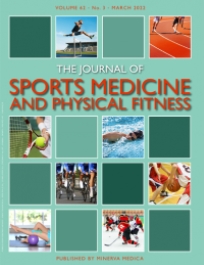Romagnoli M1,2, Sanchis-Gomar F3, Alis R1,4, Risso-Ballester1 J, Bosio A5, Graziani RL6, Rampinini E5
1, Research Institute “Dr. Viña Giner”, Molecular and Mitochondrial Medicine, Catholic University of Valencia San Vicente Mártir, Valencia, Spain; 2, Department of Physical Education and Sports, University of Valencia, Valencia, Spain; 3, Research Institute of Hospital 12 de Octubre (“i+12”), Madrid, Spain; 4, School of Medicine, Catholic University of Valencia San Vicente Mártir, Valencia, Spain; 5, Human Performance Laboratory, MAPEI Sport Research Center, Italy; 6, Clinical Biochemistry Laboratory CEDAL, Gallarate, Italy

AIM: Professional soccer players are subjected to substantial physical loads during competitive seasons. We aimed to explore the changes induced by a soccer match on muscle damage and inflammation biomarkers, and their relationship with fatigue parameters. METHODS: Twenty young male professional in-field soccer players from an Italian Serie A team (age 17-20 years, weight 73.0±7.0 kg, height 1.81±0.05m) played a 90-minute soccer match. Players’ distances and velocities were recorded during the match. Before the match and 30 minutes, 24 and 48 hours after the match, blood samples were drawn and a full blood cell count was determined, along with serum creatine kinase (CK), interleukin 6 (hsIL-6), cortisol and testosterone. At the same time intervals, counter-movement jump (CMJ) performance was recorded. RESULTS: The players covered fewer meters at low velocities in the second period while the meters covered at higher intensity remained unchanged. CMJ height was lower at all post-game time-points compared to the pre-game measurement. Immediately after the match, CK, hs-IL6 and neutrophil counts were elevated. 24 and 48 hours after the match, CK and neutrophil counts remained significantly elevated. The distance covered during the game was found to be correlated with the values for post-match hsIL-6 (ρ=0.521, p=0.027), post 24-hour cortisol (r=0.502, p=0.034) and the increase in cortisol at 48 hours with respect to pre-match values (r=0.515, p=0.029). CONCLUSION: A soccer match provokes a transient systemic imbalance that results in muscle damage and inflammatory and performance- related parameter changes. HsIL-6 and cortisol could be used to monitor recovery processes and as fatigue markers, even for short time periods.
J Sports Med Phys Fitness. 2015 Nov 11. PMID: 26558831